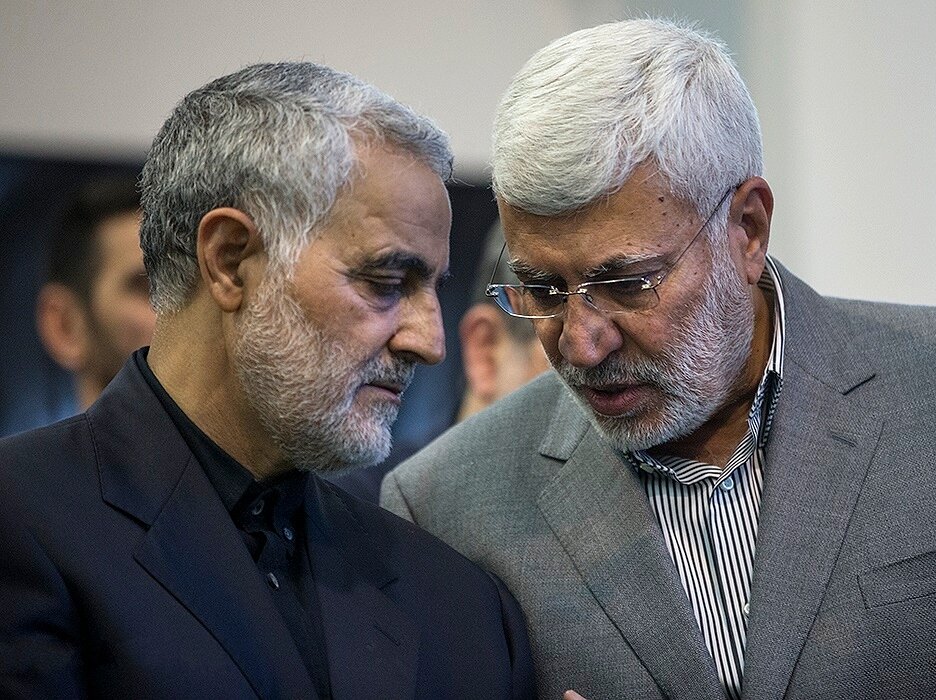PICTURED: General Qasem Soleimani and Abu Mahdi al-Muhandis at the funeral of Soleimani’s father. CC 4.0
WASHINGTON, February 14, 2020. In a notice responding to a legally mandated report requested of the executive from Congress regarding the assassination of Maj. General Qassem Soleimani, President Trump and his cabinet have changed the legal justification for carrying out the January 2nd attack again.
The new report follows yet another line of flimsy and potentially illegal justification, and explains to Congress that “the President directed this action in response to an escalating series of attacks in the preceding months by Iran and Iran-backed militias”.
“The purposes of this action were to protect American personnel, to deter Iran from conducting or supporting further attacks against the United States forces and interests, to degrade Iran and Qod’s Force-backed militias’ ability to conduct attacks, and to end Iran’s strategic escalation of attacks on, and threats to United States interests”.
For days after the strike, members of the Trump White House reported it was based on the self-defence clause located in Article 51 of the United Nations Charter, while other times invoking the 2002 AUMF against Iraq. Sec. of State Mike Pompeo and others like Rep. Mike McCaul (R – TX) referenced the blood of some 600 or so American soldiers killed during the Iraq War as being “on Soleimani’s hands”.
Strength in numbers appears to be the guiding strategy behind this new policy line, with the following paragraphs of the notice going on to invoke Article 51, the 2002 AUMF, and Article II of the Constitution.
Contradictions
Prominent House Democrats haven’t let the matter rest, with Ro Khanna (D – CA) sponsoring the No War With Iran Act which would also repeal the troublesome 2002 AUMF for the Iraq war, and Chair of the House Committee on Foreign Relations Eliot Engel (D – NY) wrestling with the State Department to get Mike Pompeo to testify before the committee on the legality of the strike.
“This official report directly contradicts the President’s false assertion that he attacked Iran to prevent an imminent attack against United States personnel and embassies,” said Engel in a statement. “The administration’s explanation in this report makes no mention of any imminent threat and shows that the justification the President offered to the American people was false, plain and simple”.
“Each passing day raises new questions about the strike that killed General Soleimani. Was there really an imminent threat?” Engel said in a statement the day before a committee hearing in late January which Mike Pompeo was supposed to attend but declined. The purpose of the hearing was to establish facts about the assassination.
“We heard the strike went forward because Soleimani did so many bad things in the past and was plotting for the future, but when that didn’t work they went back to an imminent threat, but we don’t know where or when it would take place, in fact we don’t even know if it was imminent,” Charmain Engel said in his opening remarks.
“Next an embassy was going to be attacked, then 4 embassies were going to be attacked, then maybe it wasn’t 4 embassies…”
Empty words
Taken piece by piece, the strongly worded report on the President’s decision to commit assassination is, as Engel put it, false. The idea that government A can act in self-defense against government B based on actions taken against people of yet different nations months previously while also providing no evidence that such actions were taken by government B, is not how Article 51 of the United Nations Charter is to be read.
Article 51 does indeed grant sovereign nations the ability to conduct preeminent strikes if it means preventing hostilities against them, but this is clearly not the case.
The escalating series of attacks, of which the report specifically mentions none, carried out by Iran and Iran-backed militias, could be referring to the instances of oil tanker sabotage which while Iran might very well have done, remains nothing more than an unproven hypothesis, with members of the State Department and CENTCOM saying one thing, the captain aboard the tanker another.
Article 51 of the United Nations Charter could be used equally effectively by Iran to justify the downing of a U.S. drone over their sovereign airspace in late 2019.
“The airstrike against Soleimani in Iraq is consistent with this longstanding interpretation of the President’s authority under Article II of the 2002 AUMF,” reads the executive notice. While that may be the current administration’s interpretation, it’s not for any administration to claim the power to make war based on interpretations.
The 2002 AUMF was based on the proven-false-many-times-over claims that Saddam Hussein was sitting on a nuclear weapons stockpile and that he meant to sell them to international terrorist organizations like al-Qaeda.
He and his regime are long gone, and if a president wants to invoke the AUMF for attacking Iran or Iran-backed militias for attacks they carried out months ago, or in the case of an imminent threat, of which there were none and which the executive is no longer claiming there were, then that threat or those attacks would have at the very least needed to be carried out within Iraq, or against Iraq.
The Strait of Hormuz, the oil fields of Saudi Arabia, and Iranian airspace are not Iraq, and if there were any other preceding attacks of an escalatory nature, there has been no specific reference made in the notice to Congress.
“Such uses of force need not address threats from the Iraqi government apparatus only, but may address threats to the United States posed by militias, terrorist groups, or other armed groups in Iraq,” the notice explains. Soleimani had been officially invited by the government of Iraq, and of the militias the notice constantly mentions, they are official parts of that same government’s military whether the U.S. likes it or not.



